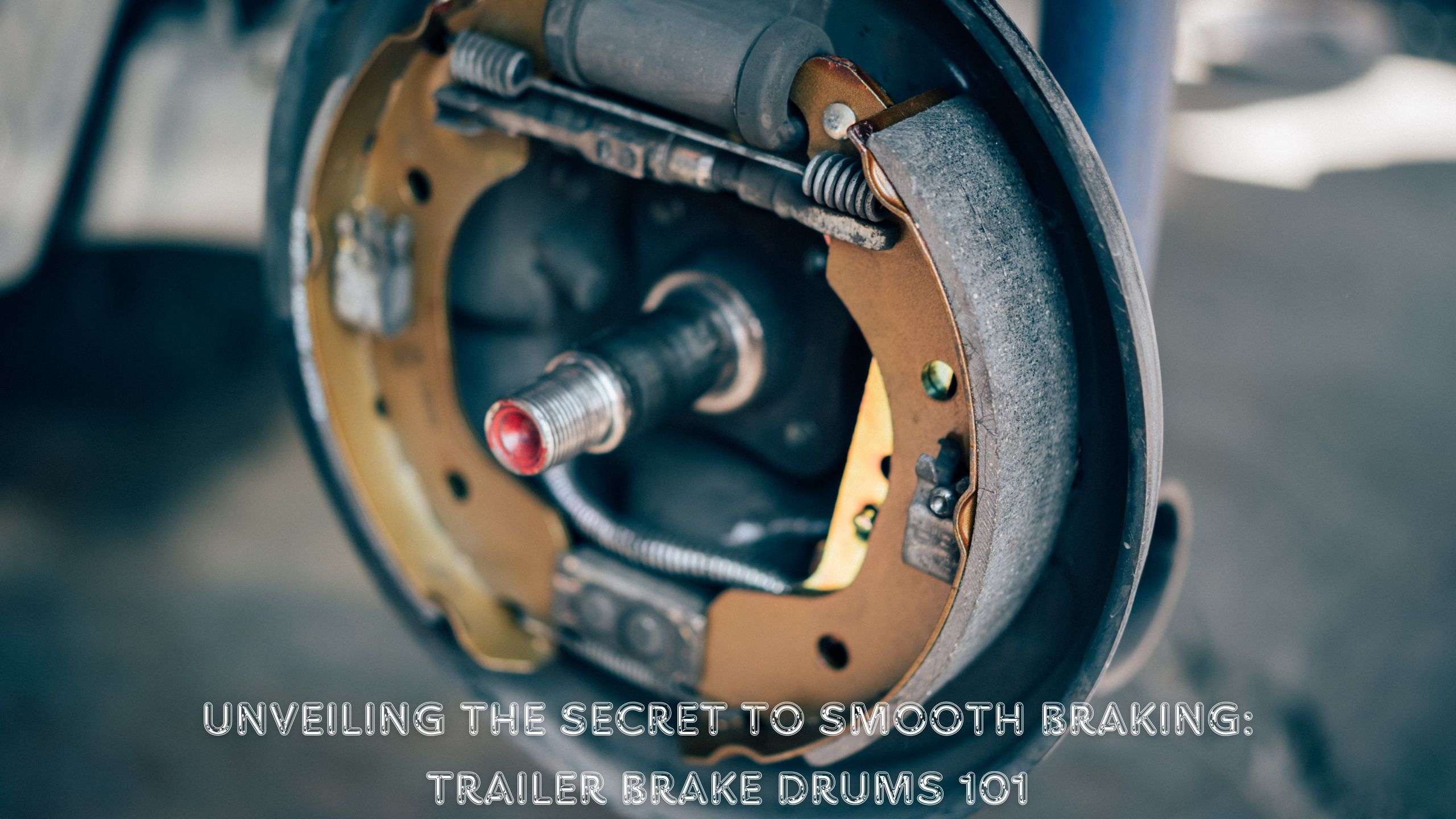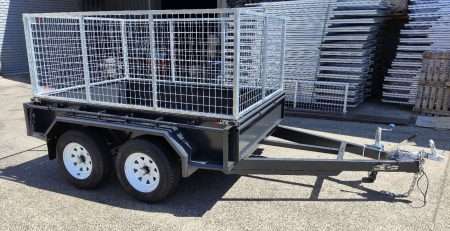
Unveiling the Secret to Smooth Braking: Trailer Brake Drums 101
Understanding brake drums
When it comes to heavy-duty transportation, having a reliable braking system is crucial. This is where trailer brake drums come into play. In this section, we’ll help you understand the role of brake drums and the different types available on the market.
The Role of Brake Drums
Trailer brake drums are integral to the optimal performance of a vehicle’s braking system, ensuring safe and efficient stops in heavy-duty transportation. They are a critical part of the braking system of trailers, as they provide the friction necessary to slow down or stop the trailer.
Cast iron or steel is typically used to make these components because these materials possess the strength and durability necessary to withstand the high temperatures and forces generated during braking. Understanding how these parts work can help you ensure that they’re in good condition and functioning effectively, which is critical to your trailer’s overall performance and safety.
Different types of brake drums
When it comes to the types of brake drums, there are several options to choose from. The choice depends largely on the specific requirements of your trailer and the load it will be carrying. Heavy-duty applications commonly use trailer brake drums for hauling large loads or towing heavy equipment (etrailer.com).
One of the types of brake drums you might come across is the drum brake. Known for their reliability and durability, drum brakes are less prone to damage from debris and other environmental factors compared to disc brakes (etrailer.com).
It’s important to choose the type of brake drum that best suits your trailer’s needs and ensures optimal performance. Therefore, understanding the distinct characteristics of each type can help you make an informed decision.
In the subsequent sections of this article, we will delve deeper into the materials and manufacturing of brake drums, their working mechanism, maintenance, and safety implications. This comprehensive guide aims to equip you with the knowledge necessary to make the right choices for your trailer’s braking system and ensure safe, smooth rides.
Materials and manufacturing
In understanding the world of trailer brake drums, it’s essential to delve into the materials used for their construction and the manufacturing standards they should meet.
Materials used in brake drums
Trailer brake drums typically consist of cast iron or steel, materials renowned for their strength and durability. These attributes are crucial for withstanding the high temperatures and forces generated during braking.
In addition to strength and durability, the materials used for brake drums should exhibit a high and stable friction coefficient, appropriate wear resistance, heat resistance, heat dissipation, and heat capacity. These characteristics contribute to the reliability of brake drums, which directly impacts the driving safety of a vehicle.
| Material | Strength | Durability | Heat Resistance | Wear Resistance |
|---|---|---|---|---|
| Cast Iron | High | High | High | Moderate |
| Steel | High | High | High | High |
Tire bolts connect the brake drums to the axle hub. When the vehicle is braking, the air brake system pushes the camshaft to rotate, spreading out the brake shoes to apply pressure to the brake drums, generating braking torque, and stopping the vehicle.
Furthermore, we can classify brake drums as common brake drums (made of a single material or bi-metal) and brake hub-drums (which combine the wheel hub and the brake drum into one).
Complying with Technical Standards
Brake drum materials are chosen for their physical properties and compliance with technical standards. These drums are heat-treated to increase their strength and durability (fleet maintenance).
Ensuring the right balance of materials and adherence to manufacturing standards is a pivotal step in producing high-quality trailer brake drums. Such meticulous details make these components reliable and safe, contributing to the overall performance of the trailer.
Remember, a well-maintained braking system is a cornerstone of safe driving. Always prioritise maintenance and inspections to ensure your trailer’s braking system, including trailer wheel bearings, is in optimal condition.
The working mechanism of brake drums
Let’s delve into the mechanics of trailer brake drums, focusing on how they generate friction and how they interact with other components in the braking system.
How Brake Drums Generate Friction
The brake drum is an integral part of the braking system of trailers, as it generates the necessary friction to slow down or stop the trailer. When the brake pedal is applied, the brake shoes inside the trailer brake drum press against the inner surface of the drum, creating friction that slows down or stops the trailer.
In essence, the brake drum and brake shoes work in conjunction, providing stopping power to the trailer by generating friction against each other. This friction slows down or stops the rotation of the trailer wheels, effectively halting the vehicle.
Interaction with Other Components
Trailer brake drums don’t work in isolation. Their operation relies heavily on the air brake system and their connection to the axle hub through tire bolts. When the vehicle is braking, the air brake system pushes the camshaft to rotate, spreading out the brake shoes to apply pressure to the brake drums. This action generates braking torque, which plays an essential role in stopping the vehicle (LinkedIn).
The brake drum is the core component of a vehicle’s braking system. Its reliability directly affects the driving safety of a vehicle, highlighting the importance of routine maintenance and inspection to ensure its optimal operation.
To maintain a well-functioning braking system, it’s crucial to not only focus on the brake drums but also on other components like trailer brake controllers and trailer wheel bearings. A well-maintained braking system ensures the safety and longevity of your trailer.
In our next section, we’ll cover more about the maintenance of trailer brake drums, including routine inspection and how to identify signs of wear and damage.
Trailer Brake Drum Maintenance
The lifespan and effectiveness of your trailer brake drums are heavily reliant on proper maintenance practices. The following sections will guide you through the routine inspection and maintenance processes, as well as how to identify signs of wear and damage on your trailer brake drums.
Routine inspection and maintenance
To ensure the longevity of your trailer brake drums, regular inspections and maintenance are crucial. This process includes checking for wear and tear, lubrication, and adjustment of brake shoes and other components (Norstar Company).
During routine maintenance checks, inspect the drums for signs of wear and damage. Any signs of wear beyond the specified limits require immediate replacement of the drums. Worn drums can reduce braking performance and compromise safety (Norstar Company).
In addition to these inspections, regular lubrication is essential for the smooth functioning of the brake drums. Applying a thin layer of high-temperature brake grease to the contact points can prevent rusting and ensure seamless operation.
Identifying Signs of Wear and Damage
Identifying signs of wear and damage on your trailer brake drums is an integral part of the maintenance process. Some common signs of wear include a deep groove in the drum surface, cracks, heat spots, or an irregular drum surface.
If these signs are ignored and the drums are not replaced, it can lead to reduced braking performance, increased stopping distance, and, in severe cases, potential brake failure. This poses a significant safety risk for the vehicle and its occupants.
Maintaining your trailer brake drums is not an isolated task. It’s part of a bigger picture that involves regular check-ups and maintenance of all trailer components, including trailer hitch locks, trailer brake controllers, trailer lights and wiring, and trailer leaf springs. This holistic approach to trailer maintenance ensures not just smooth braking but the safe and efficient operation of your entire trailer.
Choices for Trailer Brake Drums
Making the right choice for trailer brake drums depends on several factors, from the type of trailer to cost considerations. In this section, we will delve into the key factors in selecting brake drums and the cost considerations to keep in mind.
Factors in Selecting Brake Drums
When choosing trailer brake drums, you can base your selection on the OEM number of automobile manufacturers, axle manufacturers, or brake drum manufacturers, brake drum drawings, or the basic sizes of a brake drum.
There are different types of brake drums available on the market. Common brake drums include single-material brake drums and bi-metal brake drums. There are also brake hub-drums, which combine the wheel hub and the brake drum into one and are mostly used on light-duty trailers.
Additionally, the compatibility of the brake drums with the other components of the trailer’s brake system also influences the choice. It’s crucial to ensure that the brake drums are compatible with the trailer brake controllers and trailer wheel bearings to ensure smooth and efficient braking.
Cost Considerations
Considering the cost is also a critical part of selecting the right trailer brake drums. Brake drums are less expensive to manufacture and replace compared to disc brakes, making them a cost-effective option for trailer owners (etrailer.com).
Moreover, drum brakes are generally easier to service and maintain, as they have a simpler design and require fewer components compared to disc brakes. This simplicity translates to cost savings in terms of maintenance and repairs over the long run.
In conclusion, the selection of trailer brake drums should align with your trailer’s requirements and budget constraints. Always consider the type of trailer, compatibility with other components, and cost implications when selecting the best brake drums for your trailer. Keep in mind that investing in high-quality brake drums can enhance your vehicle’s safety and performance in the long run.
Safety Implications of Brake Drums
The importance of brake drums for a vehicle’s safety can’t be overstated. These components are critical for the vehicle’s braking system, affecting its overall performance and safety. In this section, we’ll explore the effect of brake drums on vehicle safety and the consequences of neglecting their maintenance.
Effect on Vehicle Safety
Brake drums play a crucial role in generating braking force and hindering vehicle movement. Therefore, they directly impact the driving safety of a vehicle. They are responsible for creating the friction necessary to slow down or stop your trailer.
In combination with other components such as trailer brake controllers and trailer safety chains, brake drums ensure that your vehicle can stop safely and promptly when needed.
However, worn-out or improperly maintained brake drums can lead to reduced braking performance, resulting in increased stopping distance and even potential brake failure. These factors pose a significant safety risk for the vehicle and its occupants.
The Consequences of Neglecting Maintenance
The maintenance of trailer brake drums should be a priority for any vehicle owner or operator. Regular inspections and maintenance are critical to ensuring the safe and efficient operation of trailers.
Excessive brake drum wear can lead to reduced braking performance, increased stopping distance, and potential safety hazards. This wear can be caused by various factors, including improper brake adjustments, contaminated linings, and excessive heat buildup.
Neglecting the maintenance of your brake drums can lead to severe consequences, including costly repairs, decreased vehicle performance, and an increased risk of accidents. Therefore, regular inspections and timely replacements or repairs are vital to maintaining the safety and performance of your vehicle.
Remember, your trailer’s safety isn’t just about its brake drums. Other components like trailer wheel bearings, trailer leaf springs, and trailer lights and wiring also play crucial roles. By ensuring that all these parts are in good working condition, you can safely hit the road with your trailer.
Author
I am Rahatul Ashiq Tamal. Another author of Muscle Trailers. Muscle Trailers is a well-known trailer brand in Sydney, Melbourne & Adelaide

How to Mount a Spare Tire on Your Trailer: A Simple Step-by-Step Guide
Trailer service centers receive over 1 million phone calls and 1.3 million emails each year about trailer maintenance problems....

How to Fix RV Roof Leaks: Simple Roof Leak Detection Guide for Beginners
Did you know DIY RV roof repairs can cost under $50? But undetected leaks could lead to substantially higher repair...

Starting a Food Truck Business in Australia: From Trailer Selection to Launch
The Australian mobile food market has evolved into a billion-dollar industry. This makes a food truck...
